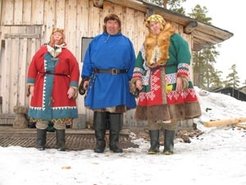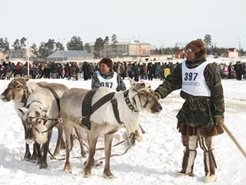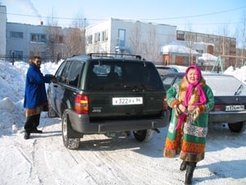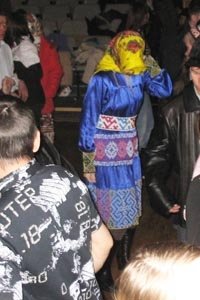Diversity of lifestyles between reindeer herders’ camps in the taiga and the oil city Kogalym, Western Siberia
Kogalym is one of the most flourishing cities in Western Siberia’s booming Khanty-Mansi Autonomous Region. Notwithstanding the negative effects of oil extraction for the environment and the social-economic situation of the Khanty reindeer herders, a great number of them keep living on their traditional forest campsites outside the city. Many families share markedly traditionalist views. They have preserved their native language better than most other Khanty groups. The number of their reindeer has grown. Nevertheless, Khanty reindeer-herding families are economically dependant on compensation payments from the oil industry, which grant them a living standard higher than that of indigenous peoples in parts of Russia where no oil is produced.
Between dissociation and retreat, adaptation and amalgamation, people in this region have been developing new strategies in response to social change. Every-day life shows a variety of lifestyles evolving between Taiga campsites and oil cities. These form the main topic of my research. Lifestyles can be understood as an expression of social inequality (Bourdieu 1979). Their diversification mirrors the growing possibilities of consumption of leisure products and the development of resistant identities that stand against globalization, as Castells (1997) has shown (the exclusion of the excluders by the excluded).



Diversity of lifestyles between reindeer herders’ camps in the taiga and the oil city Kogalym, Western Siberia
Khanty reindeer herders come to city to sell meat and forest products on the market. There they negotiate with oil industry managers about compensation and measures to mitigate the negative effects of oil extraction on their land. Some young Khanty now live in the city, working at the oil fields. Conversely, some Russians live with their Khanty spouses on taiga campsites. Employees in cultural institutions in the city are professionally concerned with the culture of the Khanty. Through my research I will explore the everyday life of families in the city and taiga, what townspeople do in the forest and forest inhabitants do in town, and how they perceive these spaces. In addition, non-everyday events in which Khanty interact with the urban sphere will be an important field of research.
Research Questions

In many different situations, Khanty today conform to a wide range of norms and practices of showing (public representation) and hiding (multiple forms of avoidance connected with taboo, shame, the sacred, the impure, and the indecent).
To research public representations of indigenous culture I will document and describe events and festivities such as the “Day of the Reindeer Herder” or the 60th birthday of a famous indigenous poet and politician. I will focus on the very divergent perspectives of different actors in these events and on visible markers of cultural differences.
Complementing the analysis of public representation, I will investigate the interrelations of practices of hiding and avoidance. There are taboos connected with the division between the realm of the death and the living, concepts of impurity and danger. There are practices of avoiding contact between special groups of relatives and practices of hiding in connection with outsiders such as tourists or representatives of the media or oil industry. In my research I will seek to find out if concepts of liminality, communitas and transgression can be applied for a more nuanced understanding of those practices.
Another area of my research will be the impact of technical innovations: electricity and mobile phone networks in the taiga, surfaced roads, and the use of snowmobiles and all-terrain vehicles all had a considerable impact on the communication and transport infrastructure between taiga campsites and city. Their (non-) availability goes hand in hand with new processes of lifestyle differentiation, exclusion and social inequality.
Moreover, lifestyle diversity is influenced by assumptions and stereotypes about life in town and in the forest. Ultimately, my research aims at exploring how Khanty lifestyles develop in an alternative space or niche, and the mechanisms of social and cultural seclusion that facilitate their existence.
References
Balzer, Marjorie M. 1999. The tenacity of ethnicity. Princeton: Princeton University Press.
Bourdieu, Pierre 1979. Die feinen Unterschiede – Kritik der gesellschaftlichen Urteilskraft. Frankfurt am Main: Suhrkamp.
Castells, Manuel 1997. The Power of identity. The Information Age – economy, society and culture, vol. 2. Oxford: Blackwell.
Golovnev, Andrei V. 1995. Govoriashchie kul’tury: tradicii samodiicev i ugrov. Ekaterinburg: UrO RAN.
Jordan, Peter 2003. Material culture and sacred landscape: the anthropology of the Siberian Khanty. Oxford: AltaMira Press.
Wiget [Uiget], Andrew and Olga Balalaeva (eds) 1999. Ocherki istorii traditsionnogo zemlepol’zovaniia khantov. Ekaterinburg: Tezis.



